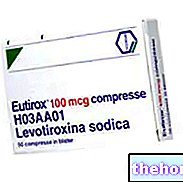
Contraindications and warnings
During the treatment with doxazosin it is important that the doctor follows the course of the therapy at regular intervals, in order to evaluate the efficacy of the drug; these controls are even more important in elderly patients, who may be more sensitive to the side effects of doxazosin.
Patients who use doxazosin for the treatment of arterial hypertension should pay more attention to the concomitant use of other drugs, unless this combination has been previously agreed with their doctor. The drugs to which particular attention must be paid are those without prescription (because we tend to think that they are '"light" "drugs, with negligible side effects, so we often forget to inform your doctor about their use) , such as appetite control medications, asthma medications, cough and cold medications, and antipyretic medications, all of which tend to increase blood pressure, for example.
After administration of doxazosin, especially after the first dose of treatment, undesirable effects such as dizziness or sudden syncope may occur, particularly when standing up from sitting or lying down; to avoid such undesirable effects it is recommended to take doxazosin before bedtime. However, even in this way, patients must be careful in case they get up at night (especially elderly patients, because they are more likely to get up during the night). In these cases it is recommended to get up slowly to try to alleviate the onset of dizziness and syncope. If you feel dizzy, it is recommended to lie down immediately, to avoid fainting, and to remain seated for a few minutes to prevent dizziness from returning. Dizziness and sudden fainting tend to affect people who consume alcohol, who stand for a long time during the day or who exercise, especially during the warmer months, more frequently. Therefore, during treatment with doxazosin it is recommended to be careful of the amount of alcohol consumed and take extra precautions on hot days or if you have to stand for a long time. In a limited number of people, doxazosin may cause a slight decrease in alertness, so it is recommended to make sure that after taking the drug the attention threshold has not decreased before getting behind the wheel, operating various machinery or doing anything that requires maximum attention. However, even in the people in whom it occurs, this slight attention deficit tends to disappear after some time from the beginning of therapy.
Very rarely the administration of doxazosin can give a very annoying side effect, priapism, which is a prolonged and painful erection of the penis; in this case it is recommended to seek medical assistance immediately. Other drugs that can interfere with the effects of doxazosin are vasodilator drugs and nitrate derivatives (antianginal drugs), which can significantly potentiate the hypotensive effect of the drug, thus causing dizziness and sudden syncope. 5-phosphodiesterase inhibitors too. , such as sildenafil (Viagra), tadalafil (Cialis) and vardenafil (Levitra) - when given at the same time as doxazosin - can potentiate the hypotensive effect of the drug and promote the symptoms mentioned above, therefore it is recommended that doctors inform patients about the possible consequences of "joint intake of the two drugs.
Doxazosin is contraindicated for the treatment of symptoms of benign prostatic hyperplasia when the patient also has concurrent upper urinary tract congestion, urinary tract infection or bladder stones. Furthermore, the use of doxazosin is contraindicated in patients who have a "history of orthostatic hypotension.
Furthermore, to avoid the occurrence of undesirable effects such as drop in blood pressure or sudden syncope, and also to minimize these effects if they occur, it is recommended to monitor the patient at the start of treatment with doxazosin and after any possible dose increase. .
To avoid complications, due to the vasodilating properties of doxazosin, a controlled administration of the drug is recommended in patients with severe heart conditions, such as heart failure with high cardiac volume per minute, pulmonary edema due to mitral or aortic stenosis. , right ventricular heart failure due to pulmonary embolism and left ventricular heart failure with low filling pressure; in patients with severe ischemic heart disease, a sudden drop in blood pressure can cause further worsening of angina disorders.
"Floppy Iris Syndrome" (IFIS - "Intraoperative Floppy Iris Syndrome", a variant of small pupil syndrome) developed during cataract surgery on some patients treated or previously treated with tamsulosin. isolated reports following the use of other alpha-1 blockers and the possibility that this effect is common to the whole class of drugs cannot be excluded. Since IFIS can cause increased procedural complications during cataract surgery, the surgeon must be informed of concurrent or previous use of alpha-1 blockers before surgery takes place.
Pregnancy and breastfeeding
Should a patient who takes doxazosin for the treatment of arterial hypertension remain incite, it is recommended to notify the attending physician as soon as possible. From several animal studies, conducted to study the effects of doxazosin on the fetus, it has emerged that doxazosin passes the placental barrier; in studies conducted on rabbits it was noted that doxazosin, in doses 300 times higher than those used in therapy, causes an increase in fetal mortality.The same animal studies, conducted in rabbits and rats, have shown no danger to the fetus of the rabbit up to doses that are 154 times higher than those for therapy in humans, while the dose that does not cause any undesirable effects on the fetus of the rat is equivalent to 75 times the dose used in therapy in humans. However, since animal studies cannot 100% simulate the behavior of the drug in the human organism, the use of doxazosin during pregnancy should only be done when strictly necessary and when the benefits for the mother are greater than the possible dangers. for the fetus.
Due to the lack of specific studies, there are no reliable data on the secretion of doxazosin in breast milk, but based on the fact that most drugs are excreted in breast milk, special care is recommended when administering doxazosin to mothers who breastfeed.
Side and unwanted effects
Along with the desired therapeutic effects, a drug can also cause side or unwanted effects. Although most patients using the drug do not experience any adverse effects, it is a professional obligation to mention all possible side effects that could occur following the administration of a given drug, ensuring that the patient is well informed and that can notify your doctor if any of these effects occur.
The most common side effect that can occur following the administration of doxazosin is dizziness, due to the hypotensive effect of the drug. Another fairly common side effect of doxazosin is sudden fainting; to prevent this effect from manifesting itself or to mitigate its entity, it is advisable not to get up suddenly, not to remain standing too long and not to expose yourself excessively to the hot climate; if you were to perceive the impending fainting, it is recommended to lie down for a few minutes and then - before getting up - to sit another couple of minutes. Other less frequent side effects are those related to the gastrointestinal system, such as constipation and diarrhea, those related to the kidneys and urinary tract, such as increased urine production and frequent urination, those related to the respiratory system such as nasal congestion and dyspnoea, and those related to the cardiovascular system such as tachycardia, arrhythmia, edema, palpitations heart disease, orthostatic hypotension and peripheral ischaemia. However, all the undesirable effects mentioned appear to be attributed to the pharmacological properties of doxazosin and are transient, as well as generally resolving over time during continued therapy. In some cases the administration of doxazosin can cause an increase in the levels of nitrogen and creatinine in the blood.























-nelle-carni-di-maiale.jpg)




